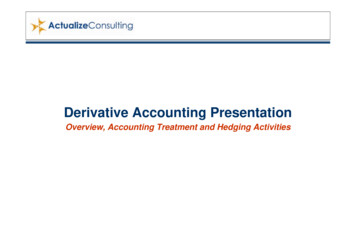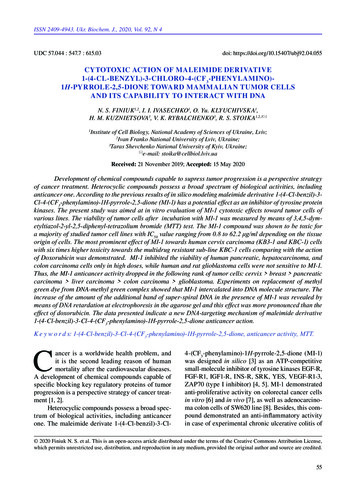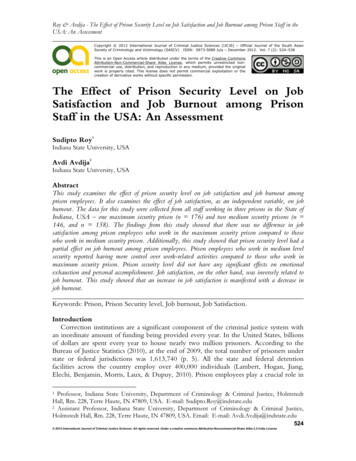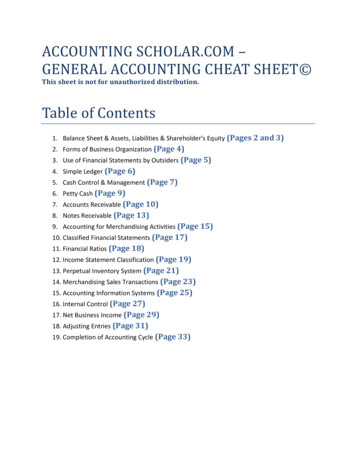
Transcription
Derivative Accounting PresentationOverview, Accounting Treatment and Hedging Activities
Accounting for DerivativesTable of Contents1.2.3.4.5.6.7.8.9.Business Reasons for DerivativesTypes of DerivativesFAS 133 Accounting for DerivativesA. MTM AccountingB. Hedge AccountingEmbedded Derivatives (FAS 155)Fair Value Option (FAS 159)Fair Value Measurement (FAS 157)Differences between FAS133 & IAS 39Reporting & DisclosureOperational Challenges2
11Business ReasonsReasons forfor DerivativesDerivativesBusiness
Accounting for DerivativesWhat is a Derivative?Derivatives are financial instruments whose returns are derived from thoseof other financial instruments.By using derivatives, companies and individuals can transfer, for a price,any desired risk to other parties who either have risks that offset or want toassume that risk.4
Accounting for DerivativesBusiness Reasons for Using DerivativesHedgingTrading to limit their exposure to adverse movements in the price of anasset.ArbitrageTrading to lock in riskless profits.SpeculationTrading to take a position in the market, effectively betting on theprobability of future price movements.5
Accounting for DerivativesRole of Derivatives MarketsRisk ManagementDerivative prices are related to the prices of the underlying spot marketand can be used to reduce or increase the risk of owning the spot items.Price DiscoveryForward and futures markets are an important source of informationabout future spot prices.Operational AdvantagesCommissions and other trading costs are lower than spot marketGreater Liquidity than the spot marketMarket EfficiencyPrices reflect true economic values of underlying assets.6
Accounting for DerivativesCharacteristics of DerivativesOnce referred to as “off-balance sheet” instruments, now required to becarried on the balance sheet at fair market valueLeverage - Subject to significant change in value (potential for gain or loss)with little or no initial investmentCash or net settlement – typically settle in cash based on the change invalue of the underlying, without actually delivering or taking delivery of anassetMay be exchange-traded or over-the-counter (“OTC”)May be “embedded” in other instruments7
22Types ofof DerivativesDerivativesTypes
Accounting for DerivativesTypes of DerivativesOption ContractsForward ContractsFutures ContractsSwaps and SwaptionsTotal Return SwapsEquity DerivativesCredit Default Swap9
Accounting for DerivativesOptions Call - A contract giving the holder the right, but not the obligation, tobuy a specific asset for a fixed price during a specific period. Put - A contract giving the holder the right, but not the obligation, tosell a specific asset for a fixed price during a specific period.10
Accounting for DerivativesUses of OptionsPurchased puts - used in situations similar to short forwards/futuresPurchased calls - used in situations similar to long forwards/futuresDecision may be based on:Likelihood of hedged transaction occurringUse options to protect downside while retaining upside (likeinsurance policy)11
Accounting for DerivativesOptionsImportant d vs. NakedIntrinsic ValueEmbedded/Freestanding OptionsExotic OptionsUnderlying FuturesSwaps12
Accounting for DerivativesOption CharacteristicsPurchaser pays/seller receives a premium up frontPurchaser enjoys upside potential with downside limited to premiumpaidSeller bears downside risk with upside limited to the premiumreceived13
Accounting for DerivativesOptions Profit/Loss TerminologyCallPutIn-the-MoneyX Less than PX Greater than PAt-the-MoneyX PX PX Greater than PX Less than POut-of-the-MoneyX exercise (or strike) priceP current underlying stock price14
Accounting for DerivativesOption PremiumIntrinsic and Time ValueOptionPremium Intrinsic Value Time ValueIn-The-Money Options:Premium Intrinsic Value Time ValueAt-The-Money Options:Premium All Time ValueOut-Of-The-Money Options: Premium All Time Value15
Accounting for Derivatives16
Accounting for DerivativesLong OptionsOption PremiumOption PremiumIn-the-moneyOut-of the-money17
Accounting for DerivativesShort OptionsOption PremiumOption PremiumIn-the-moneyOut-of the-money18
Accounting for DerivativesOption ContractsBuy corn at 2.20/buOption WriterOption HolderAssume: market price per bushel is 2.22notional amount is 100,000 bushelsoption value is 2,400Intrinsic Value is the difference between the strike price andthe market price (100,000 bu ( 2.20 - 2.22) 2,000)Time Value is the value of the option less the intrinsic value( 2,400 - 2,000 400)19
Accounting for DerivativesForwardsDefinition:A contract to buy or sell a specified amount of an asset at a specified fixedprice with delivery at a specified future point in time.Parties to forward contract typically pay nothing to enter into contract at itsinception.Price of forward contract is the price that makes the values of both the longand the short zero at contract initiation.The total change in the value of the forward contract is measured as thedifference between the forward rate and the asset’s spot rate at the forwarddate.20
Accounting for DerivativesDifferences BetweenForwards and Futures ContractsForwardsFuturesPrimary marketDealersOrganized ExchangeSecondary marketNoneThe Primary acts ExpireRare DeliveryCollateralNoneInitial Margin, Mark-to-MarketCredit riskDepends on PartiesNone [Clearing House]Market participantsLarge FirmsWide Variety21
Accounting for DerivativesUses of Forwards and FuturesSell forward/futures to hedge exposure to falling prices:Lock in profit margin on commodity inventoryLock in profit margin on future commodity sales/production with fixedcost structureForeign currency receivables or revenue stream - sell currency forwardto lock in dollar amount to be receivedIn anticipation of a debt issuance, sell a US Treasury security forward toprotect against rising interest rates (falling bond prices)22
Accounting for DerivativesUses of Forwards and FuturesBuy forward/futures to hedge exposure to rising prices:Raw materials used in manufacturing - lock in purchase price to protectmarginsForeign currency payables or forecasted cash outflows - buy currencyforward to lock in dollar amount paidInstitutional investor that anticipates buying a bond or other debtinstrument – buy US Treasury security forward as a hedge againstfalling interest rates (rising bond prices)23
Accounting for DerivativesForwards & Futures IllustrationConvey 100,000 euros in 90 daysPay 85,000 in 90 daysOption in9090days .days .AssumedAssumedspotspotraterateinin9090days days GainGainininvaluevalueofofforward forward Option Holder 85,00085,00090,00090,000 5,0005,00024
Accounting for DerivativesAdvantages Of Futures OverFowards To Control RiskFutures are easier to sell shortHave lower transactions costsHave lower margin requirements which provide greater leverageopportunitiesMake longer durations achievable– Most bonds have maturities less than 30 years at issuance; thus, achievinglong durations is difficult with bonds alone.25
Accounting for DerivativesSwap ContractsAn agreement by two parties to exchange a series of cash flows in thefutureTypically interest rates or currencies, but may also involve commodities orequities as well.Very Customizable26
Accounting for DerivativesInterest Rate SwapsImportant NotesEasily, the most important and most prevalent derivative product is theplain-vanilla interest rate swapEntering into swap exposes you to credit riskTypes of SwapsPlain VanillaFlavored Amortizing – decreasing notional amountsAccreting – increasing notional amountsSeasonal – seasonally changing notional amountsRoller coaster – wildly fluctuating notional amountsOff-market – pay rates not at current market rates27
Accounting for DerivativesCurrency SwapsPlain Vanilla Currency SwapFloating rate cash flows (usually based on LIBOR) in dollars, while theother cash flows (in another currency) are based on fixed rate.Entered to gain access to loanable funds in a foreign currency thatmight be too costly to obtain from a foreign bank.Differs from interest rate swaps Counterparties exchange notionals on effective date and returnthem at maturity date. Periodic interest payments are not settled on net basis.28
Accounting for DerivativesSwap Contract DiagramPays uerIssuerOfOf 10 10MillionMillionReceivesDebtDebt8% fixedPays 8%fixedCreditorsCreditorsIf variable rate is 7.5%, Debtor:Pays to creditors . (800,000)Pays to bank counterparty . (750,000)Receives from bank counterparty .800,000Net interest expense . 750,00029
Accounting for DerivativesSwaptionsThe right, but not obligation, to enter into an interest rate swap having apredetermined fixed rate at some later date.1. Payer Swaption or put swaption.Gives the buyer the right to be the fixed-rate payer (and floating-rate receiver) in aprespecified swap at a prespecified date.Buyer will exercise option if interest rates rise and pay the lower rate specified inthe swap.2. Receiver Swaption or call swaption.Gives the buyer the right to be the fixed-rate receiver (and floating-rate payer) in aprespecified swap at a prespecified date.Buyer will exercise option if interest rates fall and receive the higher rate specifiedin the swap.30
Accounting for DerivativesTotal Return Swaps1.Requires total return receiver to pay periodic floating payments inexchange for the total return from an underlying bond or loan,including any cash flows and price changes.Bears the default risk as well as other types of risks that lead to bonddeclining in value.Benefits by gaining exposure to an asset without actually having to buy theasset.2.Total return payer agrees to receive the floating payments and paythe total return on the underlying.Benefits by removing risk but accepts a lower total return if the underlyingasset does not experience default, a widening credit spread and/ordowngrade.31
Accounting for DerivativesEquity Derivatives ProductsSingle stock futures are derivatives on specific stock (e.g., Cisco)Equity basket derivatives are futures, options or swaps where the underlyingis a non-index basket of sharesStock market index futures are derivatives on stock exchange indicesAn equity index swap is an agreement between two parties to swap two setsof cash flows on predetermined dates for an agreed number of yearsHybrid derivatives on equity include convertible shares such as warrants orconvertible bondsEmployee stock options are also equity derivatives32
Accounting for DerivativesCredit Default SwapDefinition: A specific kind of counterparty agreement which allows thetransfer of third party risk from one party to the otherCredit default swaps capture the largest volume among credit derivativesA credit default swap involves a protection buyer and a protection sellerThe potential loss on a reference asset (e.g. bond) due to specific eventssuch as default, credit downgrade, or bankruptcy becomes the responsibilityof the protection sellerIn return, the protection buyer pays the seller periodic or upfront fees33
Accounting for DerivativesCommon Uses of Derivatives for HedgingExposure to variability in interest rates Issuance of floating rate debtExposure to fluctuations in currency rates Future revenue received in non functional currency (Third party of intercompany transactions) Future expense incurred in non functional currency (Third party of intercompany transactions) Issuance of foreign denominated debtExposure to fluctuations in commodity prices Future sales in which commodity value drives sales price Future purchases of commodities used in business operations34
33FAS 133133 –– DerivativesDerivatives AccountingAccountingFAS
Accounting for DerivativesIntroduction to FAS 133FAS 133 is a complex accounting standard that can have alarge financial and operational impact such as:Volatility in financial statementsSignificant changes in risk management strategiesChanges in key business processesChanges in computer systemsRisk management opportunities and obstacles36
Accounting for DerivativesIntroduction to FAS 133FAS 133 establishes accounting and reporting standards for:Derivative InstrumentsHedging ActivitiesFAS 133 requires all derivatives to be measured at fair valuewith changes in the fair value reportedIn current earnings (MTM accounting) orUnder Hedge Accounting guidance37
Accounting for DerivativesBroad Objectives of FAS 133 Continue FAS 52 hedge accounting treatment for existing instruments andexposures Build on the concept of entity-based transaction hedging. Increase the consistency of hedge accounting treatment for all instruments. Broaden the scope of eligible foreign currency exposures and hedginginstruments.forecasted transactions (including inter-company transactions)complex hedging instruments (collars, participating forwards)38
Accounting for DerivativesFAS 133 DefinitionA financial instrument or other contract with:One or more underlyings (an interest rate, per-share price, fx rate, orother variable)One or more notional amounts or payment provisionsNo initial net investment (or small investment in relation to risk assumed,e.g., option premium)Terms that permit net settlement, can readily be settled net, or providesfor delivery of an asset that puts the recipient in a position notsubstantially different from net settlement (par. 6-9)39
Accounting for DerivativesFAS 133 - CornerstonesDerivatives should be reported as assets and liabilities in the financialstatementsDerivatives should be measured at fair value; hedged items should beadjusted towards their fair valueOnly items that are assets and liabilities should be reported as such infinancial statementsHedge Accounting is special accounting that should only be permitted forqualifying transactions40
Accounting for DerivativesFAS 133 – Scope ExceptionsThe following items are specifically excluded from the definition (andscope) of FAS 133 (par. 10):– Loan commitments (except for mortgage loans that will be held for sale)– Regular way securities trades (shortest period)– Normal purchases and sales– Certain insurance contracts: Traditional life insurance contracts Traditional property and casualty contracts Most financial guarantee contracts– Climatic, geological & other physical variables (trading weatherderivatives are MTM under EITF 99-2)– Generally, stock-based compensation– Other specific exclusions41
Accounting for DerivativesFAS 133 – Scope ExceptionsRegular way tradeOutside scopeNormal sales andpurchasesDebt and equityinvestmentsWithin scopeFinancialguaranteesInterest rate swapsTraditionalinsuranceStock compContingent purchasepriceCurrency swapsPurchased/written optionsNet settled commodity contractsClimaticvariablecontractsEquity indexedcontractsFutures42
Accounting for DerivativesFAS 133 – Non Qualifying ExposuresPortfolio of dissimilar itemsHeld To Maturity debt securities (interest rate)Future intercompany transactionsForecasted (except FX)Items already at fair value through earningsEquity method/consolidated investeesMinority interestsFirm commitment to acquire/sell businessYour own equity43
Accounting for DerivativesDerivative Financial Statement ImpactsManagementIntentionBalance Sheet ImpactIncome Statement ImpactImpact onComprehensive Income?Derivatives Held forSpeculationThe derivative (if an asset) istreated as an investment at FairValue and FASB 115 applies. Ifthe derivative is a liability, then itshould be reported in the liabilitysection at Fair ValueIncrease or decrease in thefair value of the derivative isreported in Net IncomeNoneFair Value HedgeDerivative (as an asset or liability)is reported at Fair Value.Hedged Asset or Liability is alsonow carried at Fair Value.Increase or decrease in theFair Value of the derivative isreported in Net IncomeThe offsetting debit or credit isapplied to the Fair Value ofthe Hedged ItemNoneCash Flow HedgeDerivative (as an asset or liability)is reported at Fair ValueOffset is carried in AccumulatedOther Comprehensive Incomeuntil the future transactionoccurs.No impact on incomestatement until the futuretransaction occurs. At thattime, the increase or decreasein the fair value of the cashflow hedge is reclassified intonet income.Yes. Current period gains andlosses are reported as OtherComprehensive Incomeadjustments to Net Income –until the future transactionoccurs – then OCI balance isreclassified into Net Income44
3A3AFAS 133133 –– MTMMTM AccountingAccountingFAS
Accounting for DerivativesMTM AccountingDerivative instruments are valued at fair value with changesin fair value reported in current earningsAll derivative products are revalued every periodUnderlying hedged item is usually carried at cost or notrecorded on the financial statements:DebtHeld to maturity investmentsNon financial exposures such as anticipated purchases or sales46
Accounting for DerivativesMTM AccountingReasons for utilizing MTM accountingAllows economic hedging when hedge accounting is unavailableLess operationally onerous than qualifying for hedge accounting47
3B3BFAS 133133 –– HedgeHedge AccountingAccountingFAS
Accounting for DerivativesThree Type of Hedge Accounting1.Fair Value Hedge:Hedges exposures to the change in value of a recognized asset or liability, or unrecognized firm commitment.2.Cash Flow Hedge:Hedges forecasted transactions, or the variability in cashflow of a recognized asset or liability.3.Net Investment Hedge:Hedges the net investment in a foreign operation.49
Accounting for DerivativesFixed-rate assetsassetsAccounting Rule DiagramFixed-rateFixed-rateFixed-rate liabilitiesliabilitiesForecastedForecasted transactionstransactionsFloating-rateFloating-rate assetsassetsFloating-rateFloating-rate liabilitiesliabilitiesFirmFirm commitmentscommitmentsCash FlowHedgesFX-denominatedForecasted transactions(Third-party or inter-company)Fair ValueHedgesNet InvestmentHedges(I.E.(I.E. FXFXCurrency)Currency)FX-denominatedAFS securitiesor Firm commitmentsNetNet investmentsinvestments inin foreignforeign operationsoperations50
Accounting for DerivativesDesignationExampleAccounting TreatmentAccounting Rule TableBooked receivables/payablesChanges in both the underlying hedged item and thehedging instrument are recognized in current period income.Unrecognized firmcommitmentsChanges in both the underlying hedged item and thehedging instrument are recognized in current period income.This requires recording on the balance sheet any change invalue attributable to the hedged portion of the firm commitment.Cash Flow HedgesForecasted transactions(including intercompany)The "effective portion" of changes in the hedging instrumentare reported in Other Comprehensive Income (OCI) andreclassified into earnings in the same period during whichthe hedged forecasted transaction affects earnings. Anyineffective portion is recorded in current period income.Net Investment HedgesNet asset position in aforeign subsidiaryChanges in the value of the hedging instrument arereported in the same manner as the related translationadjustment.Fair Value HedgesNote: Non-derivative hedging instruments (such as foreign currency borrowings) will only qualify for special accounting treatment in those circumstancesalready allowed under FAS 52 (e.g., existing assets and liabilities, unrecognized firm commitments, and net investment hedges).51
Accounting for DerivativesFair Value Hedges – Qualifying CriteriaHedging Instrument:At inception, formal documentation of hedge relationship, risk managementobjective and strategy, including the risk being hedged and howeffectiveness will be measuredAt inception and ongoing, relationship must be expected to be “highlyeffective” in achieving offset, consistent with risk management strategyInstruments that do not meet the definition of a derivative, e.g. Treasurynotes, can not be used for hedging (some exceptions for fx hedges)Written options generally do not qualify for hedge accounting, except invery limited circumstances (only when hedging an embedded purchaseoption)52
Accounting for DerivativesFair Value Hedges – Qualifying CriteriaHedged Item:Specifically identified portion of an asset, liability, or firm commitmentA single asset or liability, or pool of similar assets or liabilities, or portionthereof, if all hedged items are expected to move within the same narrowrange ( /- 10% is OK; /- 30% is not)If hedging a financial asset or liability, can hedge the benchmark interestrate, credit risk, fx risk, or the entire change in fair value53
Accounting for DerivativesFair Value HedgeDerivatives are marked to market in earningsThe value of the hedge will be offset in the value of the underlyingexposure.Examples:Fixed rate debtFixed rate AFS securityInventoryCommodity purchase firm commitment54
Accounting for DerivativesFair Value Hedge Mechanics“Fair value” of the hedged itemChanges in fair value recorded in incomeFair value of the hedging instrument (i.e., derivative)Changes in fair value recorded in incomeNet effect?Both the derivative and the hedged item are MTM through earningsproviding an offset in P&L (any ineffectiveness will be seen in theP&L)55
Accounting for DerivativesFair Value Hedge of Inventory ExampleScenario:ABC has 1,000 barrels of inventory in a Commodity with a fair value of 1.1 million and a carrying value of 1.0 millionABC wants to hedge overall fair value of the CommodityOn 6/1/09, ABC enters into an at-the-money “matching” derivative tohedge the changes in fair value of the 1,000 barrels of the CommodityEffectiveness will be assessed by comparing entire change in fair valueof derivative to change in market price of inventory (time value will beignored for illustration purposes only)On 6/30/09, the fair value of the derivative has increased by 25,000and the fair value of the inventory has decreased by 25,00056
Accounting for DerivativesFair Value Hedge Journal EntriesAccounting Entries as of 6/30/09DerivativeEarningsTo record gain on derivativeEarnings25,00025,00025,000InventoryTo record loss on hedged inventory25,000Note: Gain and loss to P&L nets to 0.57
Accounting for DerivativesCash Flow HedgeHedges exposure to variability in cash flows attributable to a particularrisk of a recorded asset or liability, or a forecasted transactionDerivatives are marked to market and carried at fair valueThe effective portion of derivative’s gain/loss is reported in othercomprehensive income (OCI); the ineffectiveThe ineffective portion is reported in earnings, subject to the test inparagraph 30(b)OCI is adjusted to reflect the lesser of the cumulative gain or loss onthe derivative or the cumulative change in expected future cash flowsof the hedged itemEarnings are impacted to the extent the hedge is not effective (forover-hedges only)58
Accounting for DerivativesCash Flow Hedge – Qualifying CriteriaHedging Instrument:At inception, formal documentation of hedge relationship, entity’s riskmanagement objective and strategy, including the risk being hedgedand how effectiveness will be measuredAt inception and ongoing, relationship must be expected to be “highlyeffective” in achieving offset consistent with risk management strategyNon derivative instruments, e.g. Treasury notes, do not qualifyWritten options generally do not qualify for hedge accounting, exceptin very limited circumstances (only when hedging an embeddedpurchase option)59
Accounting for DerivativesCash Flow Hedge – Qualifying CriteriaHedged Item:A single transaction or series of individual transactions sharing thesame exposureThe forecasted transaction is “probable” and is a transaction with anexternal party (some fx hedges within an entity may qualify)Can hedge change in cash flows due to the benchmark interest rate,credit risk, fx risk, or entire change in cash flow60
Accounting for DerivativesCash Flow Hedge MechanicsFair value of the derivativeChanges recorded in OCI for effective portionChanges recorded in earnings for ineffective portionNo basis adjustment to the hedged asset or liabilityNet effect?Amounts in OCI recognized when the hedged item impacts earnings61
Accounting for DerivativesCash Flow HedgeExamples:Floating rate debtFloating rate AFS securityForecasted commodity purchasePlanned debt issuance62
Accounting for DerivativesCash Flow Hedge of Forecasted Inventory SaleAssumptions:100,000 barrels of Commodity A to be sold at the end of period 1. The inventorycarrying value is 1 million, and current market value is 1.1 millionOn the first day of period 1, ABC enters into Derivative Z to sell 100,000 barrels at 1.1 million at the end of periodAt hedge inception, the derivative is at-the-money (fair value is 0)All terms of the commodity and the derivative match(i.e., no expected ineffectiveness)On last day of Period 1, fair value of Derivative Z increased by 25,000 andexpected sales price of 100,000 barrels of Commodity A decreased 25,00063
Accounting for DerivativesCash Flow Hedge Journal Entries – Period 1Accounting Entries at end of period 1.Derivative ZOCI25,00025,000To record Derivative Z at fair valueCash25,000Derivative Z25,000To record settlement of Derivative Z64
Accounting for DerivativesCash Flow Hedge Journal Entries – Period 1Accounting Entries at end of period 1.Journal entries at end of period 1Cash1,075,000CGS1,000,000RevenueInventoryTo record inventory saleOCI1,075,0001,000,00025,000Earnings25,000To reclassify amount in OCI to earnings upon inventory sale65
Accounting for DerivativesCash Flow Hedge Journal Entries – Period 1Forecasted cash flows: 1,100,000Actual cash flows:DerivativeSale of inventoryTotal 25,0001,075,000 1,100,000The variability of cash flows related to the forecasted inventory sale isoffset by change in value of derivative.66
Accounting for DerivativesNet Investment HedgeThe gain or loss is reported in OCI (other comprehensive income) aspart of the cumulative translation adjustment.The accounting for a fair value hedge applies to a derivative designatedas a hedge of the foreign currency exposure of an unrecognized firmcommitment or an available-for-sale security.Similarly, the accounting for a cash flow hedge described above appliesto a derivative designated as a hedge of the foreign currency exposureof a foreign-currency-denominated forecasted transaction.67
Accounting for DerivativesThree Types of Net Investment HedgesFair value hedgeFirm commitments, AFS securities and fx-denominated assets andliabilities that give rise to transaction gains or losses under Statement52Cash flow hedgeFirm commitments, forecasted transactions and fx-denominated assetsand liabilities that give rise to transaction gains or losses underStatement 52Hedge of a net investment in a foreign operationI.e., cumulative translation adjustment68
Accounting for DerivativesFX Assets and LiabilitiesMany Hedges of FX assets and liabilities do not need to be “hedged”under FAS 133Asset or liability is remeasured at spot rate thru earnings, per FAS 52Derivative that hedges an FX asset or liability is carried at fair value also withchanges thru earningsSubstantial offset achieved, with minor mismatch due to differences in spot andforward ratesNo need for “special” hedge accounting treatment, because both sidesare marked through P&L69
Accounting for DerivativesTypes of Currency Swap Hedges(Hedges of interest-bearing FX denominated debt)Client’s Debt andSwap FlowsConverted to USD Converted to USDFixedFloatingForeign Fixed RateDebtCash FlowFair ValueForeign FloatingRate DebtCash FlowNon-Hedge** Substantial earnings offset achieved without hedge accounting70
Accounting for DerivativesDetermining Hedge EffectivenessEffectivenessIs defined as the ability of the hedging instrument to offset changes in thefair value or cash flows of the underlying hedged item.An entity may choose to exclude all or part of the hedging instrument’stime value.If the hedge fails the effectiveness test at any time during theperiod,The hedge ceases to qualify for hedge accounting treatmentAny accumulated gain/loss related to the hedging instrument mustbe reported immediately in earnings.71
Accounting for DerivativesDetermining Hedge EffectivenessIf critical terms of the hedging instrument and the hedged item are thesame, the entity can assume that the hedge will be completely effective.All terms must be documented at inception (notional/principal amounts,exchange rates, repricing dates, maturity dates).If critical terms are not the same, the entity must specify the method itwill use for assessing hedge effectiveness and the measurementapproach for determining the ineffective portion of the hedge.This assessment must be done whenever financial reports are issued, butnot less than every three months.72
Accounting for DerivativesDetermining Hedge EffectivenessForward Contracts: when effectiveness is assessed based on changes inspot rates, the forward discount/premium (based on interest rate points)would be excluded from the effectiveness test.Options: when effectiveness is assessed based on changes in intrinsic value,changes in time value would be excluded from the effectiveness test.In both cases, changes in the excluded component would be included incurrent period earnings.73
Accounting for DerivativesFinancial Statement ImplicationsMore derivatives under new definitionsCommodity contracts not considered to be “normal”Embedded derivativesDerivatives that don’t meet hedge criteria will be marked to fair valuecurrently through earningsAll ineffectiveness will be r
Single stock futures are derivatives on specific stock (e.g., Cisco) Equity basket derivatives are futures, options or swaps where the underlying is a non-index basket of shares Stock market index futures are derivatives on stock exchange indices An equity index











